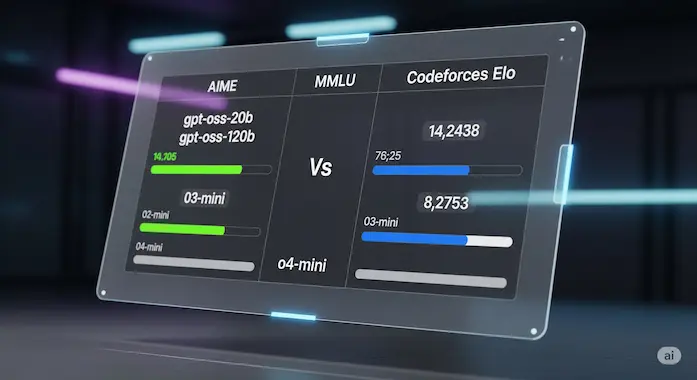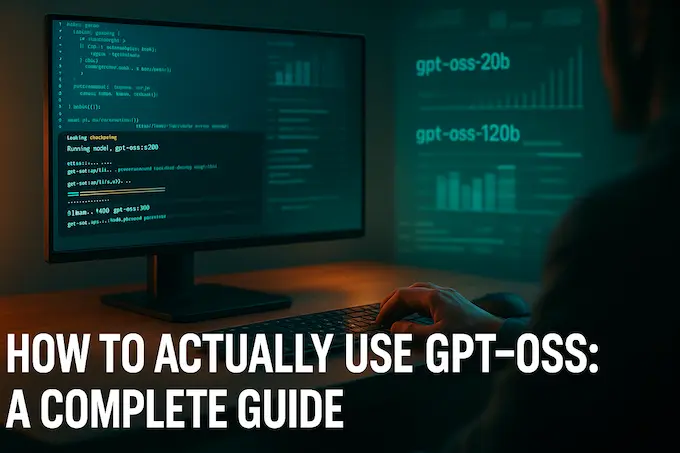Introduction: Getting Past the Hype
Scroll through any tech forum this week and you will see two camps shouting past each other. One side swears GPT‑OSS is a “ChatGPT killer you can run on a laptop.” The other side calls it “a spreadsheet with delusions of grandeur.” Both takes miss the point. GPT‑OSS is neither a miracle cure nor a dud. It is a laser‑focused reasoning engine built for developers who care more about ownership of data than tweet‑sized quips.
This guide cuts through the noise. You will learn how to install GPT‑OSS 20B in five minutes, how to build a real tool with it, and where it wins or loses against rival models. By the end you will understand why GPT‑OSS matters, which flavor to pick, and how to squeeze every drop of value from its mixture‑of‑experts brain.
Table of Contents
Part 1: What Is GPT‑OSS (And Who Is It For)?
If you have skimmed headlines you have probably met the term open‑weight. In plain English that means the full neural network weights are downloadable. You do not need an API key, an NDA, or a corporate cloud to play. Drop the files on your GPU, press run, and the model answers locally.
GPT‑OSS arrives in two sizes:
- gpt‑oss‑120b: the powerhouse. One hundred seventeen billion total parameters with 5.1 billion active at inference time. Runs happily on a single 80 GB H100, which is impressive considering its benchmark scores rival much larger proprietary systems.
- gpt‑oss‑20b: the workhorse. Twenty‑one billion parameters, 3.6 billion active, slim enough for a 16 GB consumer GPU or a modern MacBook Pro. If you are exploring at home, start here.
Not Another ChatGPT
OpenAI already sells chatty generalists. GPT‑OSS is different. It was tuned for STEM reasoning, code triage, and private deployments where compliance trumps small talk. Picture a quiet analyst who solves equations, labels GitHub issues, and never phones the cloud.
That makes GPT‑OSS ideal for:
- Fintech teams that keep source code on locked servers.
- Hospitals processing patient notes under HIPAA.
- Researchers fine‑tuning models on proprietary scientific data.
- Hobbyists who want an on‑device coding buddy without subscription fees.
If you need pop‑culture trivia on Friday night, stick with ChatGPT. If you need local control and deterministic logic, GPT‑OSS is your new friend.
Who It’s NOT For
We have already covered who will love GPT‑OSS, teams that value privacy, researchers obsessed with fine‑tuning, and builders chasing local inference. To keep expectations grounded, let’s spell out who should skip this model and look elsewhere.
- Anyone hunting for a full ChatGPT clone for trivia or poetry. GPT‑OSS can rhyme in a pinch, but its knowledge base is narrow. If you need instant facts about the 1966 World Cup, you will spend more time correcting hallucinations than writing.
- Writers wanting a fearless muse. The safety layer inside GPT‑OSS is strict by design. It swerves away from certain creative genres, especially anything spicy, violent, or morally gray. If uncensored prose is non‑negotiable, look at truly open models with looser filters.
- Teams that prize absolute top‑tier benchmarks over deployment freedom. In raw MMLU or HumanEval scores, proprietary giants like o4‑mini still win by a hair. If you happily ship data to a cloud and benchmark bragging rights matter more than sovereignty, stick with the closed API.
- Edge devices with fewer than sixteen gigabytes of RAM. Yes, the 20‑billion checkpoint is efficient, but MXFP4 still demands memory headroom. Old laptops and single‑board computers will throttle or crash. Tiny inference targets are better served by distilled seven‑billion models.
- Managers expecting “one prompt does all.” GPT‑OSS thrives when you steer it with explicit instructions, proper reasoning levels, and well‑defined tools. If your workflow cannot tolerate that extra prompt engineering, you may find simpler chatbots less fussy.
By laying out these caveats now, we save you from mis‑aligned hopes later. If your primary needs include local control, structured logic, and a license that lets you ship commercial code without a legal microscope, keep reading. If you crave romance writing, encyclopedic recall, or penny‑perfect leaderboard wins, choose a different hammer. The right tool feels magical only when applied to the right nail.
Part 2: How to Install GPT‑OSS in 5 Minutes with Ollama

When people ask how to install gpt‑oss, I give a single answer: Ollama. The project bundles downloads, quantization, and inference into one tidy binary that works on macOS, Linux, and Windows WSL.
Step 1: Grab Ollama
Visit the official page, hit the install button, or run the one-liner:
curl -fsSL https://ollama.ai/install.sh | shStep 2: Pull the Model
The command below fetches the smaller checkpoint, perfect for first tests:
ollama run gpt-oss:20bWant big-league stats? Swap 20b for 120b if your GPU can handle it.
Step 3: Unlock High Gear with a System Prompt
Many early reviewers complained GPT‑OSS “couldn’t solve a simple puzzle.” They forgot the secret key. Add one line at the very top of your prompt:
Reasoning: highI ran the classic river-crossing puzzle twice. With default settings GPT‑OSS stranded the goat. With Reasoning: high, it planned a flawless seven-move solution in under six seconds on an M3 laptop. The difference is night and day.
A Before-and-After Snapshot
| Setting | Result |
|---|---|
| Default reasoning | “I’m not sure those constraints are solvable, maybe try moving the wolf first?” |
| Reasoning: high | “Move the goat across. Return alone. Move the wolf across. Bring the goat back. Move the cabbage over. Return alone. Move the goat over.” |
This table highlights how GPT-OSS behavior shifts dramatically with the “Reasoning: high” system prompt setting.
That single tag converts GPT‑OSS from a sleepy intern into a focused analyst. Remember it.
Part 3: A Practical Example: Building Your First Agentic Tool
Promises are cheap. Let us build something you can ship by lunch.
First, Understand the ‘Harmony’ Prompt Format

Before we dive into code, let’s decode the odd‑looking markers that appear in every GPT‑OSS prompt. Those angle‑bracket tags, <|start|>, <|channel|>, and <|end|>, belong to what OpenAI calls the harmony prompt format. At first glance, the markup feels like overkill, but it solves three real problems that plague most chat models running locally.
First, the tags give the model a rigid stage direction system. Each turn opens with <|start|> and closes with <|end|>, making the conversation boundaries impossible to miss. This matters because GPT‑OSS is a mixture‑of‑experts engine, and when it loses track of who said what, it wastes tokens guessing context instead of reasoning through your request. The start‑end fence posts stop that derailment before it starts.
Second, the format splits the assistant’s output into two explicit channels: analysis and final. Think of analysis as the model’s private scratchpad. That is where its chain‑of‑thought lives, including step‑by‑step proofs or tool‑selection logic. The final channel is the polished response meant for human eyes. By funneling internal reasoning into the analysis channel, GPT‑OSS preserves transparency without dumping a wall of unfiltered text into your UI.
Third, harmony tags act as built‑in traffic lights for tool calls. When the model wants to invoke a function you exposed, it ends the analysis block with <|call|> and emits a JSON payload. Your code executes the function, returns the result, and the next assistant turn uses that data. Without this strict choreography, you would end up writing fragile regex patches to tease apart text and JSON. Harmony bakes the separation into the grammar itself.
So when you see this structure:
<|start|>system
model_identity: GPT-OSS
reasoning_effort: high
<|end|>
<|start|>developer
...
…remember each tag has a job. The system block sets global knobs, the developer block gives your own rules, and the user block states the problem. All examples in this guide rely on this structure because GPT‑OSS refuses to work reliably without it. Embrace the markup early, and you will avoid ninety percent of the head‑scratching posts clogging the issue tracker.
Our Goal: An Offline Spam Filter
Now, let’s build our practical tool: an email spam filter. It’s a perfect demo because it’s a real-world problem that requires the model to understand text and make a decision. The process involves three key steps: defining our tool in Python, describing that tool to the model, and then processing the model’s decision.
The Code
import ollama
import json
MODEL = "gpt-oss:20b"
# 1. Define the function (our "tool") that GPT-OSS can call.
def mark_as_spam(subject: str, body: str) -> str:
"""
Analyzes an email's subject and body to determine if it is spam.
Returns 'spam' or 'not spam'.
"""
spam_keywords = ["lottery", "bitcoin", "prince", "urgent notice", "claim your prize"]
email_content = (subject + " " + body).lower()
if any(keyword in email_content for keyword in spam_keywords):
return "spam"
else:
return "not spam"
# 2. Describe the tool to the model using the required harmony format.
prompt = """
<|start|>system
reasoning_effort: high
<|end|>
<|start|>developer
You have access to a tool to classify emails.
Function schema:
{
"name": "mark_as_spam",
"description": "Label an email as spam or not based on its subject and body.",
"parameters": {
"type": "object",
"properties": {
"subject": {"type": "string", "description": "The subject line of the email."},
"body": {"type": "string", "description": "The full body content of the email."}
},
"required": ["subject", "body"]
}
}
<|end|>
<|start|>user
Classify this email:
Subject: Urgent notice
Body: You have won a Bitcoin lottery. Click here.
<|end|>
"""
# 3. Let GPT-OSS decide which tool to use and run it.
response = ollama.chat(
model=MODEL,
messages=[{"role": "user", "content": prompt}],
format="json" # Ask Ollama to expect a JSON object
)
# Extract the tool call from the model's response
tool_call_str = response["message"]["content"]
tool_call_data = json.loads(tool_call_str)
# Execute the function with the arguments provided by the model
if tool_call_data.get("name") == "mark_as_spam":
arguments = tool_call_data.get("arguments", {})
result = mark_as_spam(**arguments)
print(f"The model classified the email as: {result}") # Expected output: spam
How It Works and How to Expand It
Why it works: GPT-OSS inspects the email, sees the trigger words, decides to invoke mark_as_spam, and passes the correctly structured arguments in a single step. The harmony format keeps its reasoning private and the final tool call clean and machine-readable.
This is the heart of gpt-oss tool use: you hand the model a toolbox, and it intelligently picks the right tool for the job. You could easily expand this by adding a second function, like summarize_email. The model would then choose which tool to call based on the user’s request, creating a simple but powerful email-processing agent that runs entirely on your local machine.
Part 4: The Reality Check: GPT‑OSS Benchmarks vs. the Competition

Buzzwords fade. Numbers stick. This section looks at gpt‑oss benchmark results drawn from verified model cards and trusted community runs. Two tables tell the story. The first pits GPT‑OSS against the best open models. The second lines it up against OpenAI’s own proprietary engines.
4.1 GPT‑OSS vs. Open‑Source SOTA
| Benchmark (Higher is Better) | gpt‑oss‑120b (5.1 B Active) | GLM‑4.5‑Air (12 B Active) | Qwen3‑32B (Dense) | Kimi K2 Instruct (Trillion+) | Llama 4 70B |
|---|---|---|---|---|---|
| Model Specialization | Efficient All‑Rounder | Coding & Generalist | Generalist & Coding | Deep Reasoning | Generalist |
| GPQA Diamond ¹ | 80.1 % | 78.5 % | 74.3 % | 83.7 % | 79.2 % |
| MMLU ² | 90.0 % | 91.2 % | 90.5 % | 94.1 % | 92.5 % |
| HumanEval ³ | 88.4 % | 90.2 % | 91.1 % | 89.5 % | 87.3 % |
| AIME 2025 ⁴ | 97.9 % | 96.5 % | 95.8 % | 97.1 % | 94.6 % |
GPT-OSS excels in competitive benchmarks like AIME and GPQA, while staying efficient with fewer active parameters.
¹ GPQA Diamond = PhD-level science. ² MMLU = 57-subject college exam. ³ HumanEval = code generation. ⁴ AIME = competition math.Takeaways
- Math champion. GPT‑OSS nails AIME, proving its chain‑of‑thought muscles.
- Second place everywhere else. Just a point or two behind the leaders in GPQA and MMLU, which is impressive given its lean active parameter count.
- Efficiency badge. Five billion active parameters versus twelve or thirty‑two for rivals. That is why laptop fans stay quiet.
4.2 GPT‑OSS vs. Proprietary Mini Models
| Benchmark | gpt‑oss‑120b (Open‑Weight) | gpt‑oss‑20b (Open‑Weight) | o4‑mini (Proprietary) | o3‑mini (Proprietary) | o3 (Proprietary) |
|---|---|---|---|---|---|
| Model Size | 117 B (5.1 B Active) | 21 B (3.6 B Active) | Unknown MoE | Unknown | Unknown (Large) |
| General Reasoning | |||||
| MMLU ¹ | 90.0 % | 85.3 % | 93.0 % | 87.0 % | 93.4 % |
| GPQA Diamond ² | 80.1 % | 71.5 % | 81.4 % | 77.0 % | 83.3 % |
| HLE ³ | 19.0 % | 17.3 % | 17.7 % | 13.4 % | 24.9 % |
| Coding & Tool Use | |||||
| Codeforces Elo ⁴ | 2622 | 2516 | 2719 | 2073 | 2706 |
| SWE‑Bench ⁵ | 62.4 % | 60.7 % | 68.1 % | 49.3 % | 69.1 % |
| Tau‑Bench ⁶ | 67.8 % | 54.8 % | 65.6 % | 57.6 % | 70.4 % |
| Specialized Reasoning | |||||
| AIME 2025 ⁷ | 97.9 % | 98.7 % | 99.5 % | 86.5 % | 98.4 % |
| HealthBench Hard ⁸ | 30.0 % | 10.8 % | 17.5 % | 4.0 % | 31.6 % |
Despite its open-weight status, GPT-OSS competes impressively across benchmarks, especially in math and code tasks.
Benchmarks: ¹ MMLU. ² GPQA Diamond. ³ Humanity’s Last Exam. ⁴ Codeforces Elo. ⁵ SWE‑Bench. ⁶ Tau‑Bench. ⁷ AIME. ⁸ HealthBench Hard.What the Numbers Mean
- Near‑mini parity. On GPQA and MMLU, gpt‑oss‑120b lands within a whisker of o4‑mini. That is notable given its open license.
- gpt‑oss‑20b overachieves. The smaller model outguns o3‑mini on coding and specialized health queries while occupying a fraction of the memory footprint.
- King of efficiency. Both GPT‑OSS checkpoints post “silver medal” scores while sipping fewer active parameters per token than any proprietary peer.
4.3 The Honest Story
GPT‑OSS is not a general‑knowledge encyclopaedia. It forgets soccer scores and capital cities more often than Qwen. Yet when you hand it a structured puzzle or a slab of source code, its mixture‑of‑experts engine lights up. Add the fact that you can host it inside your firewall, and it becomes a unique value proposition.
Conclusion: A Powerful, Specialized Tool for Builders
GPT‑OSS will not replace your favorite chat companion. It was never designed to. Instead it offers something scarce in today’s AI landscape: serious reasoning that runs where you need it, on‑premises, offline, and under your control.
- It installs in minutes with Ollama, so the barrier to entry is low.
- It shines in coding, math, and structured problem-solving, outclassing many larger open models on raw efficiency.
- It respects the harmony prompt format, keeping chain-of-thought private while exposing crystal-clear answers.
- It gives teams a path to fine-tune and deploy AI without shipping data to a third party.
For engineers who value privacy, researchers who crave transparency, and companies that refuse to send sensitive IP over the wire, GPT‑OSS feels less like hype and more like a quietly revolutionary toolkit. Install it, explore gpt-oss tool use, and judge with your own benchmarks. The real story is not the marketing, it is what you build next.
Azmat — Founder of Binary Verse AI | Tech Explorer and Observer of the Machine Mind Revolution.
Looking for the smartest AI models ranked by real benchmarks? Explore our AI IQ Test 2025 results to see how today’s top models stack up. Stay updated with our Weekly AI News Roundup, where we break down the latest breakthroughs, product launches, and controversies. Don’t miss our in-depth Grok 4 Review, a critical look at xAI’s most ambitious model to date.
For questions or feedback, feel free to contact us or browse more insights on BinaryVerseAI.com.
What is GPT-OSS?
GPT-OSS is an open-weight language model family from OpenAI, released under Apache 2.0. You can download the full weights, run them locally, and even fine-tune without calling a cloud API.
How do I install GPT-OSS?
The fastest route is the Ollama GPT-OSS combo. Install Ollama, then run ollama run gpt-oss:20b. That single command fetches, quantizes, and launches the model. For larger deployments you can follow the Transformers or vLLM guides.
Is GPT-OSS better than Qwen or Llama?
It depends. GPT-OSS dominates competition math and holds its own in coding while using fewer active parameters. Qwen brings stronger general chat and trivia. Llama 4 offers balanced performance at the cost of heavier hardware.
What is GPT-OSS actually good for?
Private data workflows that cannot leave your servers.
Logic-heavy tasks like spreadsheet auditing, math tutoring, and code triage.
Agentic pipelines where the model calls functions, browses, or executes Python.
Rapid prototyping on consumer GPUs.
Why do people say GPT-OSS is heavily censored?
OpenAI trained strict refusal policies into the model. Content filters sometimes overfire, leading users to call it “lobotomized.” In practice the safety layer mainly blocks illicit requests and certain creative genres.

